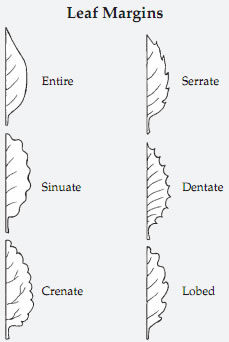 |
| Leaf margins |
The form, ormorphology, of leaves is often characteristic of individual species of plants and, like the reproductive features, is an important base of plant identification.
Some plants have a more or less cylindrical petiole that joins the base of the leaf to the stem, while others lack a petiole and are called sessile. The midrib is the prominent vein that subdivides the leaf into two halves from base to apex.
Leaf Margins
The margin is the edge of the leaf lamina lying between the apex and base. Entire margins are smooth, without indentations or incisions. Revolute margins are rolled downward, toward the lower surface of the leaf.
  |
Involute margins are rolled upward, or toward the upper surface of the leaf. Repand margins are slightly and irregularly wavy, with the lamina surface undulating in a downward and upward direction. Sinuate leaf margins are shallowly indented and strongly wavy in the horizontal plane.
Teeth
“Teeth” are commonly seen in leaf margins and typically extend less than one-eighth of the distance from the margin to the midrib of the leaf. Various shapes and sizes of teeth are associated with leaf margins.
Crenate margins have shallowly ascending round or obtuse teeth. Crenulate (minutely crenate) margins have minute, shallowly ascending round or obtuse teeth. Serrate margins have sharp, saw-toothed teeth pointing forward or toward the apex.
Serrulate (minutely serrate)margins have very fine, sharp, saw-toothed teeth pointing forward or toward the apex. Doubly serrate margins have coarse, saw-toothed teeth bearing smaller teeth on the basipetal part of their edges. Dentate margins have sharp teeth, or indentions, pointing outward at right angles to the midrib.
Denticulate (minutely dentate) margins have fine, sharp teeth, or indentions, pointing outward at right angles to the midrib. Aculeate margins have spiny or prickly projections along their edges. Bristle tips refer to teeth or lobes that are terminated by a sharp, flexible, elongated point.
Glands
Glands are small, protruding bumps on the leaf margin that are typically different in color from the surrounding lamina tissue. Often they occur at the apices of teeth or lobes or on leaf petioles. Use of a hand magnifying lens helps in observing the small glands of some species.
Tips or Apices
 |
| Leaf tips |
The apex is the tip of the leaf blade. Acuminate apices have a long, slender, sharp point, with a terminal angle less than 45 degrees, and straight to convex sides. Acute apices have a sharp-pointed tip, with a terminal angle between 45 and 90 degrees, and straight to convex sides. Mucronate apices have a tip that is terminated by a short, sharp, abrupt point.
Cuspidate apices have a tip that is abruptly and sharply constricted into an elongated, sharp-pointed tip or cusp (a sharp, rigid point). Obtuse apices have a blunt or rounded tip, with the sides forming an angle of more than 90 degrees, and straight to convex sides. Rounded apices have a tip that is curved to form a full, sweeping arc.
Truncate apices have a tip that looks as though it was cut off at almost a right angle to the midrib, forming a flattopped or squared-off shape. Retuse apices have a shallow notch in a rounded or obtuse apex. Emarginate tips have a shallow and broad notch at the apex. These are only a few of the many forms leaf apices can take.
Bases
 |
| Leaf bases |
The base of a leaf is the lower part of the lamina, where it is attached to the petiole or stem. Cuneate bases are sharp-pointed, with an angle less than 45 degrees between opposite sides which form a wedge or triangular shape that tapers to a narrow region at the point of attachment of lamina with petiole.
Acute bases have a sharp-pointed base, with opposite sides forming an angle between 45 and 90 degrees at the position where the lamina joins the petiole.
Obtuse bases have a blunt or narrowly rounded base with opposite sides forming an angle greater than 90 degrees at the position where the lamina joins the petiole. Rounded bases are curved to form a full, sweeping arc. Truncate bases look as though they were cut off at nearly a right angle to the midrib, forming a flat-topped or squared-off shape.
Cordate bases are valentine-shaped, with both right and left margins forming broad arcs that meet in the middle of the junction between lamina and petiole. Inequilateral bases have asymmetrical left and right sides of different sizes or shapes. Auriculate bases have earlike lobes where the lamina joins the petiole.